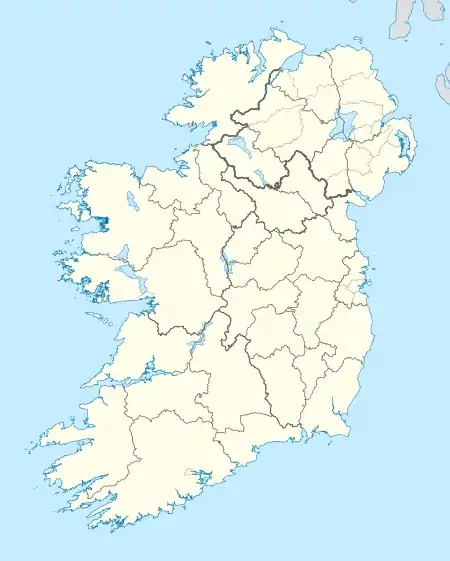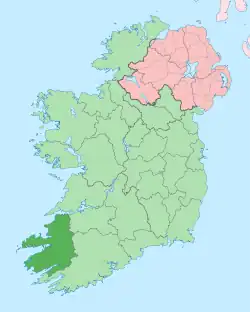Beginish Island
Beginish (from Irish: Beiginis, meaning 'small island')[1] is an island in Valentia Harbour, in south west Kerry Kerry, Ireland.[2]
Native name: Beiginis | |
|---|---|
 Beginish from the Slate quarry (Valentia Harbour) | |
 Beginish Island | |
| Geography | |
| Location | Atlantic Ocean |
| Coordinates | 51°56′N 10°18′W |
| Administration | |
| Province | Munster |
| County | Kerry |
| Demographics | |
| Population | 0 |
Geography
Dominating the northern skyline is Doulus Head and Killelan mountain, with Valentia island to the south and Ballycarbery to the east. The north west of the island faces out to the Atlantic ocean and Dingle bay. Surrounding Beginish are other small islands, including Lamb Island to the north and Church Island to the east. Church Island is notable for having the remains of a monastic settlement with an oratory and hut, holy well and shrine. On the northern edge of the island is a series of columnar basalt cliffs which have a hexagonal shape formed in a similar manner to the famous Giant's Causeway.
There are a small number of holiday homes on the island which are used seasonally. The island is used for sheep farming and some small scale forestry, and by tourists in the summer months who use the island's beaches for recreational purposes.
History
The island has numerous archaeological sites. A Viking settlement was occupied between the 9th and 12th centuries,[3] which consisted of a group of 8 houses, 15 cairns with a network of small fields enclosed by low stone walls and numerous middens. This site was excavated by archaeologist M. J. O'Kelly in the 1950s, with further analysis conducted by John Sheehan more recently.
The main dwelling currently visible was dated to the 11th century AD and is of Scandinavian-Irish origin. This circular building (6.75m in diameter) has a sunken floor 1.5 m below the surface with walls of dry masonry. It was originally covered with a thatched roof, the beams of which were held by holes in the wall. The 1.85 m long, 0.45 m wide and 0.1 m thick lintel is made of sandstone. A small cross and a rune inscription are carved into its surface, which says: "Verr erected this stone and Munulfr carved the runes". This lintel is now in the Cork Public Museum.
Occupying the highest point on the western end of the island is a block hut known locally as "Pilots lookout". This which was used in the 19th and early 20th century to spot ships coming into Dingle bay which may have required piloting into Valentia harbour.
Beginish Island is currently uninhabited. The last permanent residents were two elderly brothers who left the island in the 1990s. Beginish once hosted numerous families living from farming and fishing, most notably the O'Connell, Casey and McCrohan families.
|
| |||||||||||||||||||||||||||||||||||||||||||||||||||
| Source: "CNA17: Population by Off Shore Island, Sex and Year". Retrieved 10 October 2016. | ||||||||||||||||||||||||||||||||||||||||||||||||||||
Environment
Beginish is host to a seal colony located in a cove on the southern part of the island named Casey's landing, and has abundant bird and sea life.
Notable people
The family of legendary Kerry Gaelic footballer Mick O'Connell came from Beginish.
Sport
An annual swim of approximately 4 miles (6.4 km) takes place intermittently around the island.[4][5]
See also
References
- Placenames Database of Ireland
- "Beginish Island". About.com. The New York Times Company. Archived from the original on 2 October 2011. Retrieved 22 July 2012.
- "Beginish Island". Jump into Ireland. Tourism Ireland. Retrieved 22 July 2012.
- "Beginish Island Swim". Valentia Island Triathlon Club. Valentia Island Triathlon Club. Archived from the original on 29 April 2013. Retrieved 22 July 2012.
- "Beginish Island Swim". Active.com. The Active Network, Inc. Archived from the original on 16 January 2013. Retrieved 22 July 2012.
